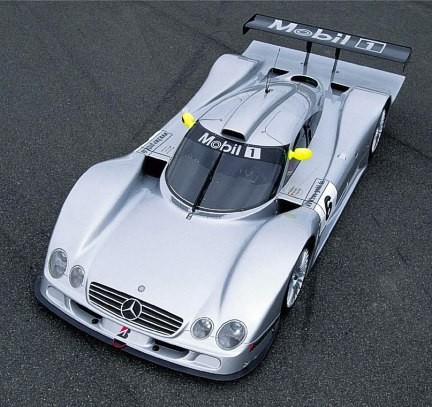The 1999 24 Hours of Le Mans is etched in motorsport history for many reasons, but for Mercedes-Benz, it remains a stark reminder of aerodynamic miscalculation. The Mercedes Clr, a car designed to conquer the legendary endurance race, instead became infamous for something far more dramatic and unexpected: taking flight. Many who witnessed the incidents, either in person or on television replays, were left with a stunned sense of disbelief. How could such a large, ground-bound machine suddenly defy gravity in such a spectacular and alarming fashion?
 The Mercedes-Benz CLR race car, known for its aerodynamic challenges at the 1999 Le Mans.
The Mercedes-Benz CLR race car, known for its aerodynamic challenges at the 1999 Le Mans.
The question of what caused the Mercedes CLR to become airborne has persisted for years. While speculation about tire failures and other mechanical issues surfaced, the root cause was more deeply embedded in the car’s fundamental design and aerodynamic characteristics. The incidents weren’t simply a matter of bad luck; they were the culmination of a complex interplay of factors rooted in the CLR’s dimensional architecture, a deficiency in overall downforce, and a degree of aerodynamic sensitivity that proved catastrophic under racing conditions.
To understand the CLR’s predicament, it’s crucial to examine its design parameters. The car was built to the maximum permissible overall length of 4890 mm. Its wheelbase measured 2670 mm, accompanied by a front overhang of 1080 mm and a rear overhang stretching to 1140 mm. These dimensions, while seemingly within regulatory limits, were critical in shaping the car’s aerodynamic behavior.
A significant rule change in 1997 by the Automobile Club de l’Ouest (ACO) allowed Le Mans Prototype (LMP) and Le Mans Grand Touring Prototype (LMGTP) cars with flat bottoms to incorporate a rear diffuser. The regulations defined the diffuser’s starting point at the rear wheel centerline but granted designers freedom to extend it as far as the bodywork’s trailing edge. Mercedes exploited this latitude on the CLR to an unprecedented extent. The CLR’s rear overhang and diffuser extension significantly exceeded those of its competitors. Consider the Toyota GT-One with a 990 mm rear overhang, the Audi R8C at 940 mm, and the Nissan R391 at a mere 880 mm – all dwarfed by the CLR’s substantial 1140 mm.
At the front, the CLR’s 1080 mm overhang was more in line with its rivals, perhaps leaning towards the longer side but not drastically so. However, the front diffuser underneath was notably smaller and less aggressive than those seen on cars like the Toyota GT-One or even the BMW LMR. Compounding this was the CLR’s relatively short wheelbase of 2670 mm, the shortest amongst the LMP field. Competitors opted for longer wheelbases to enhance aerodynamic stability – the Toyota GT-One at 2850 mm, Audi R8C at 2700 mm, and BMW LMR at 2790 mm. No other car in the CLR’s class combined such a short wheelbase with such pronounced front and rear overhangs.
This unique dimensional configuration created an aerodynamically sensitive platform. The short wheelbase meant that even minor changes in the car’s pitch attitude, induced by braking or acceleration, resulted in substantial ride height variations at the extreme ends of the long overhangs. Reports of the Mercedes CLR exhibiting porpoising – an oscillatory vertical motion – in various track sections throughout the Le Mans weekend strongly suggest an inherent instability in the car’s aerodynamic platform.
Adding to the complexity was the CLR’s coupe bodywork. The enclosed cockpit shape of a closed-top car, while offering drag reduction benefits, inherently contributes to aerodynamic lift. While modern race car designs generate significant downforce to counteract this, the cockpit bubble remains a factor that designers must carefully manage. It’s a trade-off, balancing the drag advantages of a closed cockpit against its lift-generating tendency.
Anecdotal evidence suggests that the Mercedes CLR may have been configured with soft rear springs. While this remains unconfirmed, if true, it would have further exacerbated the car’s aerodynamic vulnerabilities. Soft rear springs are sometimes employed on high-speed circuits to reduce drag and increase straight-line speed. At high velocity, rear downforce compresses the softer springs, lowering the car’s rear ride height and potentially reducing drag. However, this setup can also make the car more susceptible to pitch sensitivity and aerodynamic imbalances.
Following the practice and morning warm-up incidents, it’s understood that Mercedes consulted with renowned Formula 1 aerodynamicist Adrian Newey in a frantic attempt to find a solution. One of the measures implemented was the addition of front nose dive planes to generate more front downforce. Both CLRs commenced the race with these dive planes fitted. It’s important to remember that cars of this era, particularly in Le Mans trim, generally produced relatively low levels of downforce compared to contemporary standards. Data from the open-top Nissan R391 LMP900 indicates downforce levels between 2000-2500 lbs at 200 mph.
Mercedes-Benz, in a press release issued after the warm-up crash, aimed to reassure the public that their cars were still race-worthy, claiming that the newly added dive planes boosted front downforce by as much as 25%. Assuming a baseline downforce of 2000 lbs with a 45/55 front/rear distribution (900 lbs front), a 25% increase translates to an additional 225 lbs of front downforce. Recalculating the balance to 45/55 distribution would suggest a total downforce increase of around 500 lbs. However, even with this enhancement, the fundamental issue remained: the overall aerodynamic downforce of these cars, including the CLR, was comparatively low by modern standards.
Analyzing the “moment” of lift-off requires considering the confluence of these factors. While precise details are difficult to ascertain without direct observation of all incidents, some generalizations can be made. In most instances, the Mercedes CLR appeared to be following closely behind another car. This proximity would have reduced downforce on the CLR’s nose due to turbulent air from the leading vehicle. Furthermore, the CLR seemed to experience a change in attitude, possibly cresting a track undulation or running over a curb. These subtle shifts in the car’s orientation, however minor, could trigger significant changes in aerodynamic forces, especially given the CLR’s inherent sensitivity.
Therefore, the likely sequence of events unfolded as follows: reduced front downforce due to turbulent air from a leading car, a slight change in the CLR’s pitch attitude due to track variations, and the CLR’s heightened pitch sensitivity stemming from its long overhangs and short wheelbase. These factors combined to produce a more substantial loss of downforce than anticipated. As the low pressure zone beneath the CLR’s nose diminished, approaching zero, the lift generated by the coupe cockpit and the upper bodywork began to assert itself, further raising the nose. Simultaneously, the rear wing remained effective, firmly planting the rear of the car and creating a pivot point around the rear wheel centerline. As the front lifted, the extended rear diffuser, protruding significantly beyond the rear wheels, moved closer to the track surface, paradoxically generating even more downforce at the rear, further exacerbating the lifting effect at the front. Ultimately, the exposed underfloor and the lift from the cockpit overwhelmed the car’s downforce capabilities, resulting in a dramatic airborne incident.
Ironically, despite the severity of the incidents, Mercedes-Benz chose not to withdraw from the race after the second flip in morning warm-up, highlighting the immense pressure to succeed. Rumors circulated at the time of a potential earlier incident during testing, although these remain unconfirmed. In the years since, Mercedes has largely distanced itself from the CLR project and its Le Mans history. Their absence from the race since 1999 suggests a deep-seated desire to move past this chapter, leaving the aerodynamic enigma of the Mercedes CLR and its flight at Le Mans as a cautionary tale in motorsport engineering.
